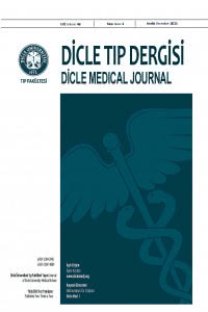Preoperatif ve İntraoperatif Klinik Bulguların Üreter Taşı Endoskopik Tedavi Başarısına Etkisi
The Effect of Preoperative and Intraoperative Clinical Findings on Success of Endoscopic Management of Ureteral Stone
___
- 1. J Fasihuddin Q, Hasan AT. Ureteroscopy (URS): an effective interventional and diagnostic modality. Pak Med Assoc 2002;52:510-512.
- 2. Watson GM, Landers B, Nauth Misir R, et al. Development in ureteroscopes, techniques and accessories associated with laser lithotripsy. World J Urol1993;11:19.
- 3. Wu CF, Shee JJ, Lin WY, et al. Comparison between extracorporeal shock wave lithotripsy and semirigid ureterorenoscope with holmium: YAG laser lithotripsy for treating large proximal ureteral stones. J Urol 2004;172:1899-1902.
- 4. Hamano S, Nomura H, Kinsui H, et al. Experience with ureteral stone management in 1,082 patients using semirigid ureteroscopes. Urol Int 2000;65:106-111.
- 5. Elashry OM, Elgamasy AK, Sabaa MA, et al. Ureteroscopic management of lower ureteric calculi: a 15-year single-centre experience. BJU Int 2008;102:1010-1017.
- 6. Delvecchio FC, Preminger GM. Management of residual stones. Urol Clin N Am 2000;27:347-354.
- 7. Sun L, Peng FL. Simultaneous saline irrigation during retrograde rigid ureteroscopic lasertripsy for the prevention of proximal calculus migration.Can Urol Assoc J 2013;7:E65- 68.
- 8. Yuksel OH, Akan S, Urkmez A, et al. Efficacy and safety of semirigid ureteroscopy combined with holmium: YAG laser in the treatment of upper urinary tract calculi: Is it a good alternative treatment option of flexible ureteroscopy for developing countries? J Pak Med Assoc 2015;65:1193- 1196.
- 9. Cabrera FJ, Preminger GM, Lipkin ME. Antiretropulsion devices. Curr Opin Urol 2014;24:173-178.
- 10. Ahmed M, Pedro RN, Kieley S, et al. Systematic evaluation of ureteral occlusion devices: insertion, deployment, stone migration, and extraction. Urology 2009;73:976-980.
- 11. Farahat YA, Elbahnasy AE, Elashry OM. A randomized prospective controlled study for assessment of different ureteral occlusion devices in prevention ofstone migration during pneumatic lithotripsy. Urology 2011;77:30-35.
- 12. Dretler SP. Ureteroscopy for proximal ureteral calculi: prevention of stone migration. J Endourol 2000;14:565-567.
- 13. Ursiny M, Eisner BH. Cost-effectiveness of antiretropulsion devices for ureteroscopic lithotripsy. J Urol 2013;189:1762-1766.
- 14. Georgescu D, Multescu R, Geavlete B, Geavlete P. Intraoperative complications after 8150 semirigid ureteroscopies for ureteral lithiasis: risk analysis and management. Chirurgia (Bucur) 2014 May-Jun;109:369-374.
- 15. Librenjak D, Situm M, Gugic D, et al. Ureterorenoscopic treatment of ureteral stones--influence of operator's experience and skill on the procedure outcome. Croat Med J 2011;52:55-60.
- 16. Moufid K, Abbaka N, Touiti D, et al. Large impacted upper ureteral calculi: A comparative study between retrograde ureterolithotripsy and percutaneous antegrade ureterolithotripsy in the modified lateral position. Urol Ann 2013;5:140-146.
- 17. Elsheemy MS, Maher A, Mursi K, et al. Holmium:YAG laser ureteroscopic lithotripsy for ureteric calculi in children: predictive factors for complications and success.World J Urol 2014;32:985-990.
- 18. Süer E, Gülpinar Ö, Özcan C, et al. Predictive factors for flexible ureterorenoscopy requirement after rigid ureterorenoscopy in cases with renal pelvic stones sized 1 to 2 cm. Korean J Urol 2015;56:138-142.
- 19. Rifaioğlu MM, Demirbas O, Davarcı M. The importance of hydronephrosis in percutaneous nephrolithotomy operation. Dicle Med J 2013;40:441-445.
- ISSN: 1300-2945
- Yayın Aralığı: 4
- Başlangıç: 1963
- Yayıncı: Cahfer GÜLOĞLU
Prematür Ejakülasyon Olgularında Cinsel Mitlere İnanma Düzeyi
MEHMET GÜNEŞ, Hasan AKÇALI, ONUR DEDE, Aslihan OKAN, Mahmut BULUT, Süleyman DEMİR, Abdullah ATLI, Aytekin SIR
Cinayet-Kompleks İntihar: İkili Ölümün Nadir Bir Alt tipi
Ramazan AKCAN, MAHMUT ŞERİF YILDIRIM, Aykut LALE, Eyüp Ruşen HEYBET
Acı Elma Yağının Yanlış Kullanımına Bağlı Dört Zehirlenme Vakası
Suzan GÜNDÜZ, Semra KARA, Çiğdem Nüket YÜKSEL, Ayse Esra YILMAZ
BİRCAN ALAN, Murat KAPAN, SADULLAH GİRGİN
Akciğer Kanserinde Cilt Metastazı: Olgu Sunumu
Gülistan KARADENİZ, Sibel DORUK, Oya Nermin SİVRİKOZ, Cenk MELİKOĞLU, Serpil Bulaç KIR
Penil Protez İmplantasyon Cerrahisi Klinik Sonuçları
ONUR DEDE, Mansur DAĞGÜLLİ, Mazhar UTANGAÇ, Murat ATAR, Gülay DEDE
Ultrasonografi ile Ölçülen Tahmini Fetal Ağırlığa Etki Eden Faktörler
Tolga KARAKAN, Emre HURİ, İlkan TATAR, HAKAN HAMDİ ÇELİK, MEHMET AKİF DİRİ, MURAT BAĞCIOĞLU, Cankon GERMİYANOĞLU
Stent Restenozunu Öngördürmede Eozinofil-Lenfosit Oranının Kullanışlılığı
MEHMET ZİHNİ BİLİK, MEHMET ATA AKIL, HALİT ACET, Murat YÜKSEL, Mustafa OYLUMLU, Nihat POLAT, Adem AKTAN, Sait ALAN
Akne Vulgarisli Hastalarda Serum Çinko Düzeyleri ve Akne Şiddetiyle Korelasyonu
